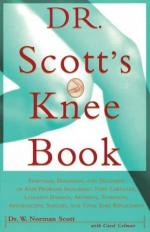|
This section contains 324 words (approx. 2 pages at 300 words per page) |
In general, cartilage is a tough, fibrous and blood vessel-free connective tissue that forms flexible linkages (such as in the ribs), supporting structures (such as in the ears and nose), and acts as a shock absorber in joints such as the knee.
Hyaline cartilage is the most common type of cartilage. Its name derives from its translucent (hyaline) appearance.
In addition to being found in articulated joints—joints capable of movement by virtue of being their sliding or hinged connection with each other--hyaline cartilage forms the majority of the skeleton of a fetus. Later in fetal development, it is replaced by bone.
The free surfaces of most hyaline cartilage (except that found in joints) are covered by a layer of fibrous connective tissue known as perichondrium. The perichondrium is rich in a type of cell known as the fibroblast. Compositionally, hyaline cartilage is made of water (75% by weight), collagen (10% by weight, mainly collagen type II), with the remainder being nonfibrous material, such as chondroitin sulfate and keratan sulfate. The collagen provides strength and makes hyaline cartilage resistant to compression. Also, the collagen provides a means by which the cartilage can be anchored to bone.
Cartilage is capable of growth. Growth occurs mainly at the cartilage surface, just underneath the perichondrium. Such active deposition of cartilage at the surface is termed apositional growth. Cells within the cartilage called chondroblasts produce the new material. It is thought that the fibroblasts resident in the perichondrium are able to convert to chondroblasts during these growth periods. As growth occurs the chondroblasts can become trapped in the cartilage. The space occupied by these cells is referred to as a lacuna, which means "small lake." In adults, the entrapped chondroblasts, now called chondrocysts, do not readily produce new hyaline cartilage. When adults sustain cartilage damage, part of the healing process involves the conversion of chondrocytes to chondroblasts, so that production of hyaline cartilage can occur.
|
This section contains 324 words (approx. 2 pages at 300 words per page) |


